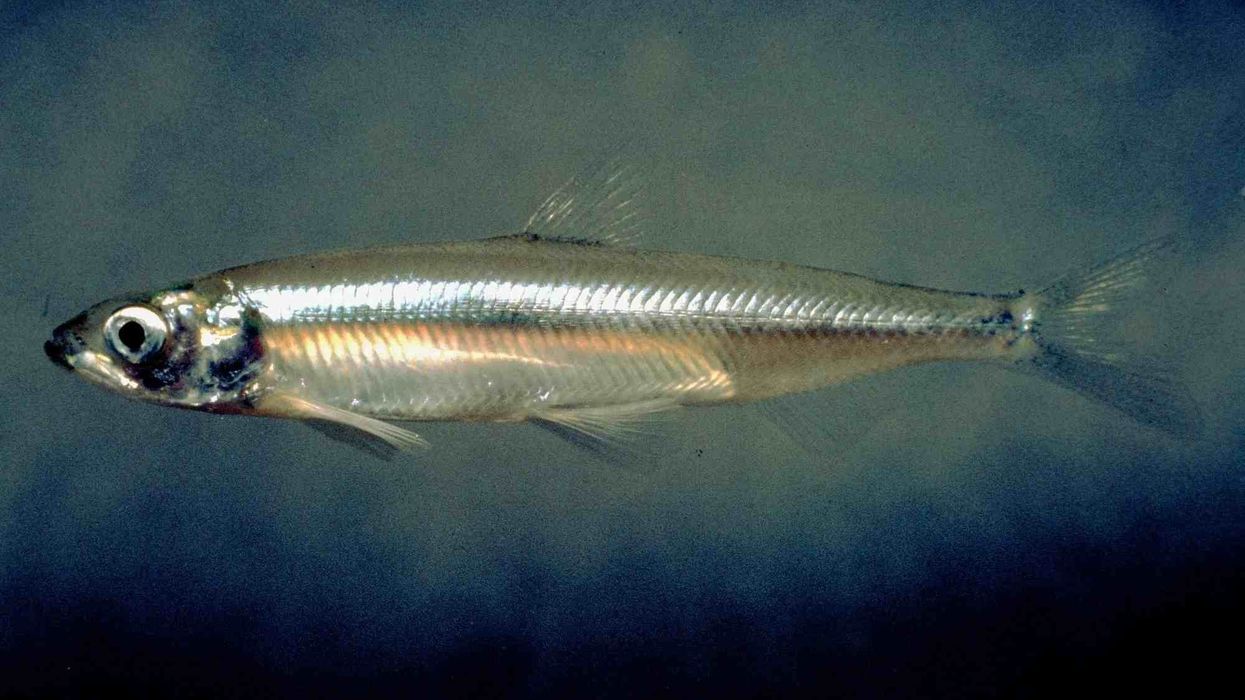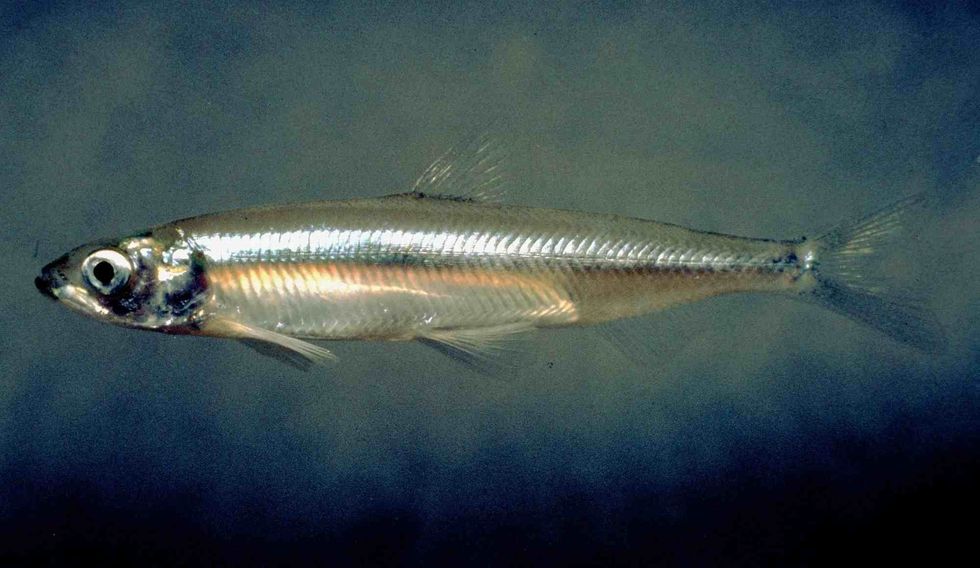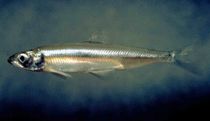Fun Delta Smelt Facts For Kids

Delta smelts are categorized as fish from the Hypomesus genus and the Osmaridae family found primarily in the San Francisco Bay, San Joaquin River Delta, and the waters of the central valley of California.
Their tiny silver body with a steely-blue sheen, Delta smelts are considered as the indicator of the Bay-Delta environment.
Its good health and habitat signify how the whole environment of the Estuary is doing.
Other fish like longfin smelt, green sturgeon, steelheads, and many others depend on this species.
The life of beach communities is controlled by this fish as well. This utterly adorable species of fish require an excellent environment for qualitative spawning and usually prefers slow-moving water.
At their young age, they eat calanoid copepods and adults usually feed on planktonic groups, insect larva, etc.
However, due to man-made disasters, like dumping toxic waste in California's water bodies in the central valley, leading to the delta smelt controversy and the loss of a balanced ecosystem, climate change and drought, dispute over the water supply of the state, high water diversions, and the like, the population of this species of delicate fish has been declared as an Endangered species by the U.S Fish and Wildlife Service and is on the verge of extinction.
This California fish species has also been listed in the Federal Endangered Species Act along with other native species like the longfin smelt and the Chinook Salmon as well because they depend on the delta smelt for food, thereby making them a very important part of the food chain.
There are several interesting and engaging facts about this tiny silver-colored fish species such as facts about their habitat, reproduction process, conservation status, and many more. If you are looking for more facts about this fish species, you can check out this article.
If you enjoy reading our articles, you can check out two other engaging articles on plaice and blue runners.
Delta Smelt Interesting Facts
What type of animal is a Delta Smelt?
Delta smelt is categorized as fish from the Hypomesus genus and Osmaridae family.
What class of animal does a Delta Smelt belong to?
Delta smelts belong to the Actinopterygii class.
How many Delta Smelts are there in the world?
The numbers vary on the basis of many surveys. According to the US Fish and Wildlife Service, only a few thousand delta fish are left. However, the exact number of existing delta fish in the world is unknown.
In the early 1980s, more than 80% of the delta smelt population had disappeared. They were marked as Threatened.
Smelt numbers increased in 1992 but declined drastically again in 2002. In 2005, they were at the lowest in number ever measured, just 2.4 % of the species remained from when they were first listed. In surveys from 2007, the numbers of juveniles were at the lowest ever recorded.
Where does a Delta Smelt live?
Delta smelts inhabit water bodies with a salinity range from 0 to 18.4 ppt and the maximum they can tolerate is a salinity level of 19.0 ppt. Delta smelts usually live in open water below 25 degrees Celsius.
They are pelagic. The larvae and juveniles live in shallow and food-rich nurseries, whereas the adult delta smelts need a habitat where water flow is adequate and water quality is suitable.
What is a Delta Smelt's habitat?
These coastal species have the power to endure salty water. Although they need great flows of fresh water for their spawning.
Sacramento San Joaquin Delta is a wide river in California. The delta and its freshwater have ecological resources. Delta smelts are also a resident of this Sacramento San Joaquin Delta.
In fact, it is an indigenous species of the Sacramento San Joaquin delta. The fish are spread from Suisan Bay through Delta in Solano Counties and Sacramento. Earlier the species was scattered from the Bay of San Pablo with upstream flows of water to Sacramento.
The process is varied due to the flow of fresh water and the seasons. For a qualitative spawning and lifestyle, the species needs a good force of water, a suitable climate, and plenty of nutritious food.
Who do Delta Smelts live with?
Delta-smelts live together in groups called schools.
How long does a Delta Smelt live?
The lifespan of a delta smelt fish is very short. They live for about one year, and after their first spawning, they die. It makes them semelparous. In rare cases, a small percentage of the species survive for two years and spawn once or twice in both years.
How do they reproduce?
They reproduce using the process of fertilization of eggs by sperms. Usually, fewer than 3,000 eggs are produced by most females. The best spawning time is from February to June.
The spawning takes place in both winter and spring. They migrate upstream for fresh water and after the egg hatch, larval and juvenile fish get swept downstream by the water flow and tides. They stay there for the summer or until autumn comes.
What is their conservation status?
Their conservation status is Critically Endangered. This means their survival is currently endangered. They are going extinct due to anthropogenic alterations to their ecosystem. There has been no clear fix of the delta smelt population.
Delta Smelt Fun Facts
What do Delta Smelts look like?

The delta smelt is a slim silver-colored fish with a thin steely-blue sheen. It has a triangular face with two round-shaped innocent and large black eyes.
The fish has small teeth and their jaw areas have a distinctive dark spot. They also possess lateral lines over their entire body.
This small finger-sized fish has the power to balance the ecosystem because they primarily play a significant role as the 'indicator' of the ecological system of the delta. The baby smelts also are known to have an oil sac that helps them to float in water because their fins develop a few weeks after birth.
How cute are they?
They are tiny and very cute. Their near translucence with a steely-blue sheen on their sides makes them look exceptionally beautiful, especially when they are in their own natural habitat. Their reflective bodies also reflect colors and light that add to the beauty of the habitat in which they live.
How do they communicate?
Delta smelts communicate with each other through sound, color, bioluminescence, motion, electrical impulses to navigate, and also to alert others so that they can keep away from predators. As well as this, they also communicate while fighting.
How big is a Delta Smelt?
The average size of the delta smelt is very small, reaching only about 2.4-2.8 in in length. They are even smaller than an average snail.
How fast can a Delta Smelt swim?
The delta smelt can swim a maximum of 0.6 mph (28 cm/s). With intermittent obstacles, they can swim at a water velocity of around 0.2 mph (10 cm/s) approximately. They use tidal force to swim upwards and downwards. Sometimes they technically avoid the tide by holding their position.
How much does a Delta Smelt weigh?
There is no specification about the weight of the delta smelt. They are very tiny so their weight has not been considered worth mentioning. A fish that is about 6-7 cm long would not weigh much at all!
What are their male and female names of the species?
There is no specific name on the basis of sex.
What would you call a baby Delta Smelt?
When delta fish come out of their eggs, they are known as larvae and then juveniles.
What do they eat?
Delta smelts are known to feed on planktonic copepods, cladocerans, and amphipods. Larvae are also known to feed on unicellular algae, planktonic animals, and small crustaceans. They migrate upstream, but tides and water flow might mean that they are pushed downstream again. The weak swimming behavior of the delta smelt allows them to stay where planktonic food is concentrated.
Are they dangerous?
They are not dangerous at all and are quite the opposite actually. They are essential for the delta ecosystem and for their communities.
Would they make a good pet?
No. They are not petting material, to begin with, but they are good for the ecosystem.
Did you know...
Excessive drought and water diversions have already threatened to render the smelt extinct. Simultaneously, the arrival of new species and a wide range of pollutants are the causes of the decline of this species.
Invasive species of fish that are non-native, like the largemouth bass, and non-native striped bass.
This small, finger-sized fish has the power to balance the ecosystem. They play a significant role as the 'indicator' of the delta's ecological system.
It is important to preserve this native California fish and help rebuild its population along with other threatened fish and wildlife species of California's water, like the Chinook salmon.
Therefore, the Fish and Wildlife Service has issued a biological opinion for the proper coordination of the State Water Project and the Central Valley Project.
The fish expert, Moyle, said that the probability of the survival of the delta-smelt in the following years is quite low, and the chances of repopulating them to the numbers they were before are also quite unlikely.
Why is the Delta Smelt endangered?
Since 1980, they were gradually declining in the upper portion of the Sacramento San Joaquin Estuary. In 1993, both the State Government and the Federal Government of California announced delta smelt species under the threatened list.
On December 19, 1994, critical habitat was listed. In the 2010 announcement, it remained unchanged.
In an April 2015 survey, there was found only one individual delta smelt. The delta smelt's population has also been endangered because a large number of toxic wastes had been released into the water of estuaries thereby increasing their salinity.
This also caused great harm to the habitat of the delta smelt. The Fish And Wildlife Service of the US has also failed to protect this valuable species from the water bodies of San Francisco and California.
Protecting the Delta Smelt
In an ecological system, each species is too important to hold the food-chain balance. Every species has to depend on others for survival.
If the delta smelt population is declining at such a fast rate then gradually many other delta species and native species will surely disappear.
There have been great efforts taken to keep the population of this species of endangered fish safe. To protect the delta smelt from a further decline, the government has limited the water pumping activities of the federal water projects, which will further be limiting the water available for farming.
Here at Kidadl, we have carefully created lots of interesting family-friendly animal facts for everyone to discover! Learn more about some other fish including neon tetra and candiru.
You can even occupy yourself at home by drawing one of our delta smelt coloring pages.
We Want Your Photos!
More for You
See All
Bachelor of Arts specializing in Journalism and Mass Communication, Postgraduate Diploma in Sports Management

Moumita DuttaBachelor of Arts specializing in Journalism and Mass Communication, Postgraduate Diploma in Sports Management
A content writer and editor with a passion for sports, Moumita has honed her skills in producing compelling match reports and stories about sporting heroes. She holds a degree in Journalism and Mass Communication from the Indian Institute of Social Welfare and Business Management, Calcutta University, alongside a postgraduate diploma in Sports Management.
Bachelor of Arts specializing in English Language and Literature, Master of Arts specializing in Philosophy and Religious Studies

Tehil DavidBachelor of Arts specializing in English Language and Literature, Master of Arts specializing in Philosophy and Religious Studies
Tehil David Singh is a fact checker with a Bachelor's degree in English literature from St.Xavier's College, Palayamkottai, and a Master's degree in Philosophy, and Religion from Madurai Kamaraj University. He has a passion for writing and hopes to become a story writer in the future. Tehil has previously interned in content writing and has been a content creator for the last three years. In his personal life, he enjoys singing, songwriting, performing, and writing stories.
Disclaimer
1) Kidadl is independent and to make our service free to you the reader we are supported by advertising. We hope you love our recommendations for products and services! What we suggest is selected independently by the Kidadl team. If you purchase using the Buy Now button we may earn a small commission. This does not influence our choices. Prices are correct and items are available at the time the article was published but we cannot guarantee that on the time of reading. Please note that Kidadl is a participant in the Amazon Services LLC Associates Program, an affiliate advertising program designed to provide a means for sites to earn advertising fees by advertising and linking to Amazon. We also link to other websites, but are not responsible for their content.
2) At Kidadl, we strive to recommend the very best activities and events. We will always aim to give you accurate information at the date of publication - however, information does change, so it’s important you do your own research, double-check and make the decision that is right for your family. We recognise that not all activities and ideas are appropriate for all children and families or in all circumstances. Our recommended activities are based on age but these are a guide. We recommend that these ideas are used as inspiration, that ideas are undertaken with appropriate adult supervision, and that each adult uses their own discretion and knowledge of their children to consider the safety and suitability. Kidadl cannot accept liability for the execution of these ideas, and parental supervision is advised at all times, as safety is paramount. Anyone using the information provided by Kidadl does so at their own risk and we can not accept liability if things go wrong.
3) Because we are an educational resource, we have quotes and facts about a range of historical and modern figures. We do not endorse the actions of or rhetoric of all the people included in these collections, but we think they are important for growing minds to learn about under the guidance of parents or guardians.







